Social media advertising spend is expected to top $47.9 billion in 2021. That’s nearly 20% of the total expected advertising spend by all North American businesses this year.
The amount of money spent on paid social media ads has been steadily climbing since 2019, and now, with businesses preparing to spend nearly a fifth of their ad budgets on this pay-to-play promo, it’s clear that social media ads are becoming a staple in marketing strategies across small and large businesses.
Ultimately, paid social media helps with targeting audiences and driving sales just as organic social media does. The advantage to paying for this type of value? Speed to market, campaign sustainability, and good old fashioned message frequency.
Organic social media traffic can take days to build due to the algorithms at work behind the scenes of the most popular social media sites. If you’re running a short campaign, that ramp up time can cost you visibility and leads. With paid social media, your campaign can get started with an extra boost at a speed that organic posts just can’t match. In addition to sustaining views, traffic, and engagement for as long as your credit card can stand, you’ll have the benefit of retargeting consumers with your ads to achieve an advertisement frequency that you can control.
In this article, we’ll discuss what paid social media is, the components of a paid social media strategy, and the top social media platforms for running paid ads.
Pay-per-click advertising, branded or influencer-generated content, and display ads are all examples of paid social media. You’ll know a paid social media advertisement when you see one based on the “sponsored” or “promoted” tag near the post.
Every social media channel is different. Twitter offers short-form content, Instagram focuses heavily on visual content, Facebook has its own marketplace for shopping enthusiasts, and LinkedIn is the home of networking professionals.
As such, paid social media on each platform differs, and should, depending on the campaign and audience.
Here, we're going to explore some quick strategies that will help you decide how to use paid social to the benefit of your brand.
Having a paid social media strategy can optimize a marketing budget that might not be substantial enough to promote a large brand through traditional media channels. If your business is working with a limited budget to reach hefty ROI goals, look no further. We've gathered the important things you’ll need to know about using paid social media ads.
To create a paid social media strategy, you’ll want to start with two critical items: An objective and a budget.
Paid Social Media Strategy Objective
Setting the objective for your paid social media strategy gives your subsequent tactics a direction to work with and a goal to achieve. Think of this strategy as a road trip. You start your journey at your house with the goal of making it to your destination by a certain time. Paid social ads work the same way — your audience is starting their journey with your brand on their newsfeed and your goal is to lead them to the destination — a content offer on your website, an email subscription form, or even your social media profile itself.
To establish where your audience is starting their journey, you’ll use filters, settings, and other criteria to narrow down your audience so that everyone you target is starting from a similar place. This doesn’t have to be a physical location (although it can be). You can target people by their age, their hobbies, and even their occupation.
Once you have your starting point, it’s time to define your destination. Different social media ad platforms have their own conversion tools, but the end goal is almost always the same — get people to share their contact information with your business. You might do this with a form fill or a visit to a landing page on your website. Either one works to reach the destination, but depending on your business’s needs, you might prefer one or the other.
Paid Social Media Strategy Budget
Paid social media advertising is one of the least expensive types of advertising available in the traditional and digital market. The pay-to-play model for these channels makes them flexible enough to target only the people your business wants to attract, therefore you only have to pay for those you have the ability to reach.
Unlike TV or radio ads that are priced based on the length of the spot and the time the ads will air, social media ads are priced based on the length of the campaign and the potential number of impressions you'll be working toward with your ads. This gives these types of ads a much more favorable KPI to track — cost per acquisition — as opposed to traditional ads that can only vaguely track cost per million impressions.
Paid social media ads can start as low as $1 because of the bidding model and lottery system some platforms use to bring ads onto users’ newsfeeds. Spending for this type of advertising is virtually unlimited, but you can set a limit that will stop the campaign from spending more money than you’ve allowed.
You’ll need to keep an eye on your credit card balance as you reach the spending limit you’ve set as these campaigns are programmed to stop running when the money runs out. That might sound helpful, but it can be annoying at best and detrimental to your campaign at worst. If you’re running a large campaign that needs a budget that exceeds the limit of your credit card, even just a few hours of downtime to pay the balance down can mean lost leads and momentum for your campaign. If your credit card needs to be paid in full each day due to a high spending limit you’ve set for the ad campaign, a lucky person or people on your team will have the honor of creating several expense reports for the duration of the campaign.
To avoid this problem, consider raising the balance on your business credit card so that you have plenty of time to pay it off before the ads max it out, or try setting a lower daily spending limit for your campaign.
Each paid social media platform has unique features that set it apart from competitors. However, there are three key characteristics of a converting paid ad that you’ll want your platform of choice to support: visual content, easy access to lead capture forms, and enough space to include enticing ad copy.
When advertising on Facebook, it's a good idea to use Facebook Targeted Ads. It’s the most robust ad platform available by far and that’s not for nothing. This feature is run on a bidding system — a type of advertising buying process where advertisers bid on a number of ads based on their preferred target audience. Then, that bid will be put into a lottery for a chance to be picked and displayed to that audience. Facebook ads can narrow an audience down to just a few hundred people based on geography, interests, demographics, and more. And while that may not be beneficial for most large corporations, it can be the difference between a slow month and a sold out day for a small business.
Other than the lottery, Facebook Ads lets you show advertisements to your customers based on their behavior. This is helpful because you can keep advertising to your existing Facebook customers based on what Facebook tells you about their use of the app.
Using Facebook Ads helps you build new leads and generate brand awareness. Facebook provides reports and analytics that are perfect for experimenting with variables like post time and content type, so try using different ad formats and see what your audience engages with most.
Facebook Ad Example: Network for Good
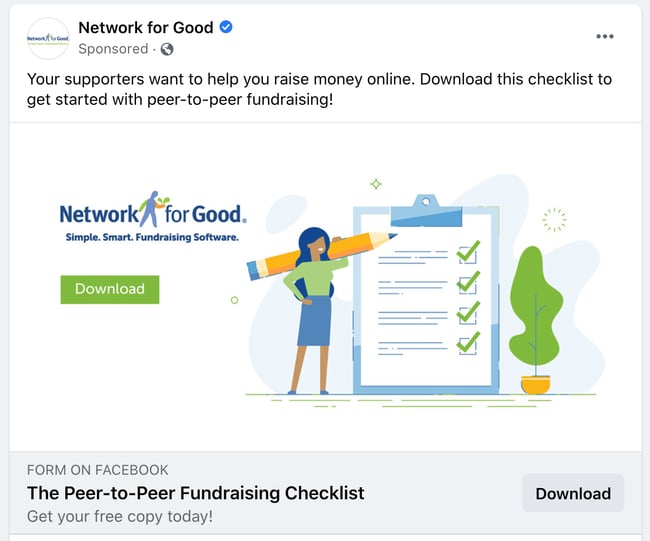
Network for Good has a strong paid social media strategy and has for a few years. As a servant leader in several nonprofit organizations, I’m targeted often with their checklists, templates, and guides on Facebook. Here’s why this ad works:
- It keeps users on the platform. When a user clicks through to download the checklist, they’re not redirected to an external website. Facebook offers businesses the option for in-app form fills (that's a lot of words to say that users remain on Facebook while they convert on the ad.) That means the user doesn’t experience much disruption when they interact with the ad and can finish their Facebook session as soon as they’re done downloading the checklist.
- There’s a prompt to drive conversation. There’s no question about what this ad wants me to do — download the Peer-to-Peer Fundraising Checklist. Simple, clear copy like this makes it easy for the user to convert on this ad because they don’t have to think about what their next step should be. They can either keep scrolling or download.
For more information about running your own Facebook Ads that can convert just like this one, check out this checklist for lesser-known tips about running successful ad campaigns on this platform.
As a consumer, paid ads on Twitter tend to sneak up on me. I barely know I'm looking at a sponsored tweet because they look so similar to regular tweets. As a marketer, this is fantastic news; it means more eyes on your ads because they're not as blatant as ads on other social channels.
Why Twitter Ads? Well, Twitter reports having 192 million monetizable daily users (the number of people who can see your ad on any given day), and when using their Ad software, you can target your ad to a specific demographic.
Twitter Ad Example: The Penny Hoarder
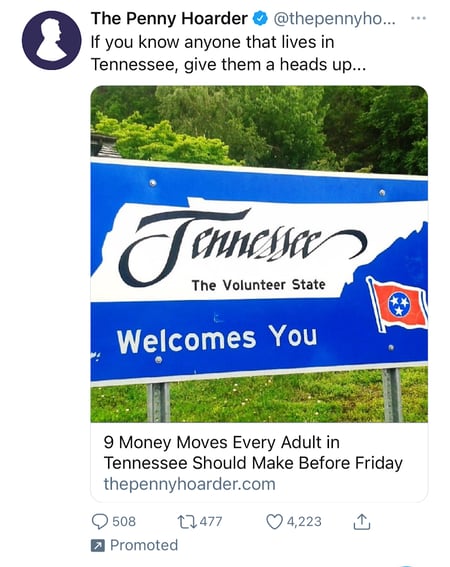
As a Tennessee native, The Penny Hoarder can deduce that I might like seeing imagery and copy about my home state. Geographically targeted ads can be successful for businesses in a broad market category — like The Penny Hoarder. Financial advice is applicable to anyone anywhere, but by positioning the content in a way that affects my life, I felt intrigued to click on the ad and learn more. Here’s why else this ad works:
- It brings more traffic to this blog article. The original article was published in August 2020, but the continuous advertising on Twitter brings in more views than it might receive organically. Unlike Facebook, which has devised ways to keep people on the site longer, Twitter allows users to visit the Penny Hoarder Website and read the article with just one click.
- It’s visually appealing. Geography is just one way to evoke emotions and resonate with consumers in an ad. By framing this ad (and the article it’s promoting) with an identifier like Tennessee, people who live in the area or are from the area will instantly say “this has to do with me and my community — I need to care.”
Twitter provides ad settings based on your budget —like how frequently your ad will be seen, where it will be seen, and the ad type to run. When you’re ready to run your social ads on this platform, Twitter offers different formats for you to choose from based on your goals.
84% of people discover new products on Instagram — up from 64% just four years ago. With growth like this, it probably isn't a bad idea to pay for a spot in front of the 1.16 billion accounts in the platform’s advertising reach.
To run ads on Instagram, you’ll need a business profile — this allows you to set up an ecommerce store right on the app. (That’s a plus if you don’t have a website prepared to accept payments or if you’re testing out ecommerce for the first time.)
Since Facebook owns Instagram, you’ll be running ads concurrently on both platforms and they're all managed on Facebook.
Using Instagram Ads, you can choose an amount of ad spend that works for your budget starting as low as $1. This amount is tied to the timeline of the campaign and the size of your audience.
I compare Instagram ads to filling up a gas tank — you get the amount of gas you pay for. On Instagram, your ad campaign runs during the amount of time you pay for.
Instagram Ad Example: Aveeno
Aveeno utilized Instagram's ad platform to target consumers with their product. The simple design is eye-catching without becoming overwhelming and distracting. Here's why it works:
- It's visually appealing. The neutral colors and clean design draws our eyes to the product. (The pointing hand is a bonus that keeps our eye on the CTA — the shopping cart!)
- The call to action is simple. One of the great features of Instagram ads is the ability to swipe up to see more about the product or make a purchase. When you're done, it's easy to close out of the Aveeno website and continue consuming other Instagram content.
On LinkedIn, millions of professionals have found a wealth of professional connections, their dream job, or both. The platform lets you reach thousands of people in your industry including thought leaders, hiring managers, and decision-makers.
Fortunately, as a marketer, LinkedIn’s paid ads let you reach those same individuals on behalf of your business.
There are 740 million professionals on LinkedIn, and four out of five of them drive business decisions —like business purchase decisions. This is a B2B advertiser's dream come true. With the potential to reach 60 million decision-makers on the most popular social platform for lead generation, it's good to consider LinkedIn as an optimal platform for B2B advertising.
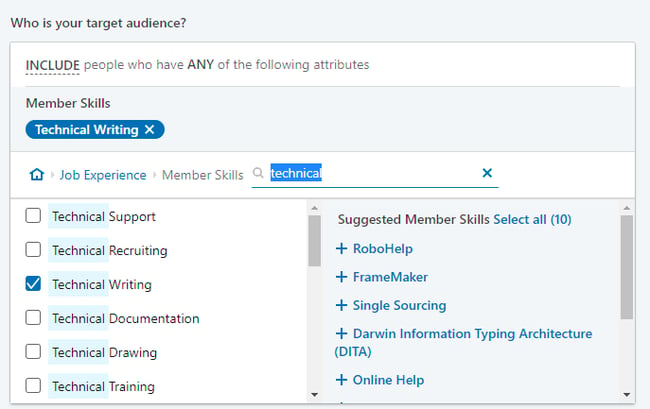
LinkedIn's targeted ads let you type in keywords and select audiences by category. So, if you're posting a job for a certain role, LinkedIn can help you find a pool of diverse candidates with relevant experience.
LinkedIn Ad Example: ON24
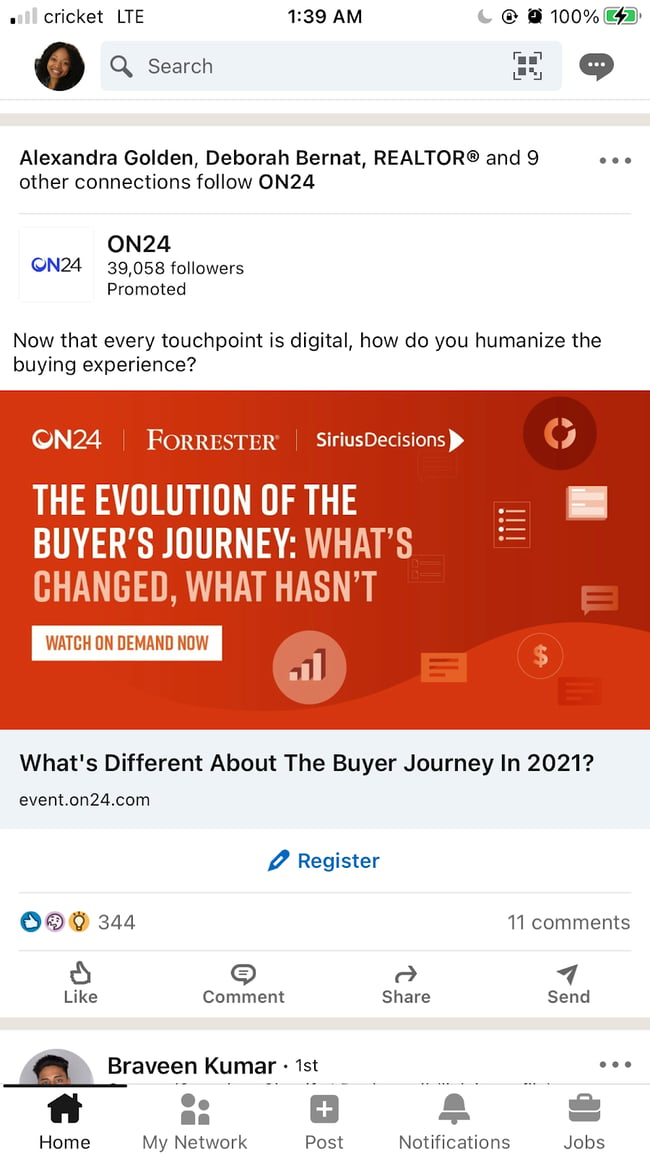
On24 uses short and sweet copy to start a dialogue with its target audience. By focusing on business use cases for its product, the ON24 can position itself as a thought leader on the topic of buyer journeys to entice LinkedIn users to register for the event. Here’s why it works:
- It keeps users on the platform. Similar to Facebook, LinkedIn uses in-app form fills to make the exchange between businesses and LinkedIn users who register for the event. That way, after they’re done registering, they can continue seeking their next opportunity, networking, or engaging with other content creators.
- There’s a prompt to drive the conversation. No matter how much money you spend on ads, there isn’t a way to buy engagement on those ads. Comments, likes, and shares still need to come organically which means the captions, copy, and headlines you choose for your ads should make the most of the limited space available. ON24 does a great job of this by asking a question that everyone has an answer to in the caption of this promoted post.
You can also play around with ad formats on LinkedIn to find which one is most effective. To find out more about the ad types on LinkedIn —such as sponsored, message, text, and dynamic — check out our post about creating an awesome LinkedIn Ad campaign.
Scaling Your Paid Social Media Strategy
When you put money behind a campaign, no matter how much or how little, you’ll want a sustainable ROI that shows the budget, effort, and resources you expended were all worth it. That ROI growth means you’ll be able to scale your campaigns in the future, and paid ads can fuel your success.
Now that you have a solid understanding of the most popular paid social media ad platforms on the market, you’ll need to track all of your hard work to realize that ROI. The native platforms we mentioned earlier do offer reporting and analytics, but what happens when you run a campaign across several different social media sites? I’ll give you a hint — it gets very messy very quickly.

HubSpot’s free ad tracking software gives you one hub in which to manage all of your social media paid ads. That means you can report the success of your campaigns in just a few clicks rather than spending an entire day hunting down the information in each native platform. You’ll also have one source of truth for the combined total impressions, reach, and clicks. That’s paid social media at scale.
Investing in paid social media — the verdict is in.
It's easy to think ad spend is just for the big brands, but making informed purchase decisions benefits every business.
The truth is, social media channels are making advertising accessible to large and small businesses alike. Once you learn how to plan, create, and position your ads to your target audience, you’ll have a much smoother time proving the ad campaign’s ROI to your stakeholders.
Editor's note: This post was originally published in February 2020 and has been updated for comprehensiveness.
from Marketing https://ift.tt/2UC7a1B
via


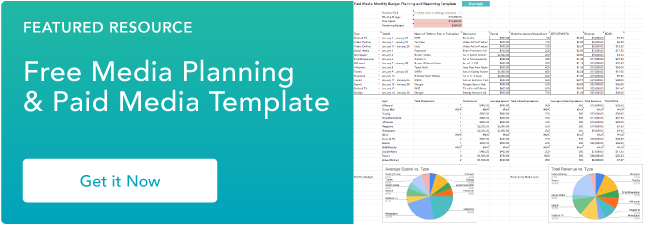
No comments:
Post a Comment